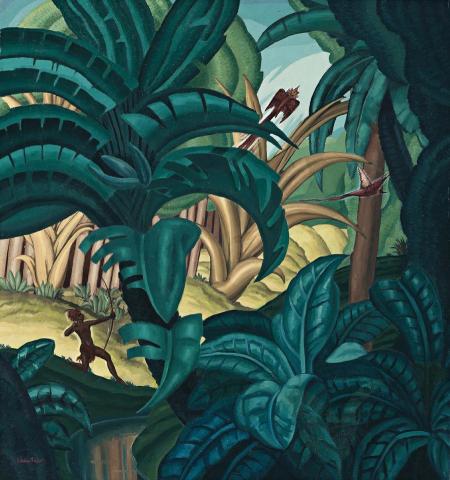HUNTER IN A TROPICAL FOREST, c.1930
ADRIAN FEINT
oil on canvas
76.0 x 71.0 cm
signed lower right: Adrian Feint
Christie's, Sydney, 3 May 1988, lot 254 (as'Tropical Flora')
Wesfarmers Art Collection, Perth (label attached verso)
The Song of the Lamb: The Wesfarmers Collection of Australian Art, Art Gallery of Western Australia, Perth, 19 August – 2 October 1989
Gooding, J., Topliss, H., Sharkey, C.,and Horridge, N., The Song of the Lamb: The Wesfarmers Collection of Australian Art, Art Gallery of Western Australia, Perth,1989, p. 84 (illus., as 'Tropical flora')
Adrian Feint has long been regarded as one of Australia's most distinguished flower painters.The esteem has been such that it tended to overshadow his excellence in other areas. His bookplate designs attracted international recognition. In 1930, the Library of Congress, Washington, devoted an exhibition to them. From 1928 to 1940 he contributed numerous brilliant cover designs for the stylish magazine Home and Art in Australia. Moreover, in1939 his glass panels of parrots and tropical fish featured in the Australian Pavilion at the New York World's Fair. His landscapes have always deserved special attention. Earlier, he had studied design with Thea Proctor; and in the late 1930s, when he turned to painting in oils, it was Margaret Preston who gave him assistance.
Although flower pieces dominated his first oil paintings, botanical correctness was invariably enveloped in creative design, flowers frequently being set in windows revealing landscapes beyond. Morning Offering, acquired by the Felton Bequest in 1942 for the National Gallery of Victoria, Melbourne, is a classic example. Sydney Harbour, with its yachts and white sails, enters through the open window, providing an appealing setting for the abundance of flowers in an elegant vase. The intimacy of the moment is cleverly heightened by the drawing aside of the curtain. In the 1940s landscapes began to appear more frequently as subjects in their own right, as in The Illawarra Flame Tree 1941 (National Gallery of Victoria by courtesy of Dr Joseph Brown), and The Jetties, Palm Beach 1942 (Hinton Collection, New England Regional Art Museum, Armidale, New South Wales). Each is characterized by striking clarity and heightened realism. Landscapes and flower pieces, however, were also moving along a Surrealist path. In Happy Landing 1944 (Art Gallery of South Australia, Adelaide), the shell-shaped cornucopia overflowing with flowers theatrically floats with dreamlike weightlessness and wonderment. The Lighthouse, (National Gallery of Australia, Canberra), is even more strikingly Surrealist in style and mood, revealing a distant kinship to the English painter Edward Wadsworth.
While Feint's paintings are highly decorative, decoration does not deny depth. For Feint makes many references to the sea and shells, traditional metaphors of life, fruitfulness and the unconscious, dressed in ineffable beauty. Moreover, the Surrealist mood continued to play an increasing role in his art. It echoed throughout the landscape-flower pieces commissioned by the Orient Line in 1946, and robed itself in exotic garb in Hunter in a Tropical Forest. Here, in a paradisiacal garden of luxuriant growth, innocence and experience unite in the eternal, happy hunting grounds of the Elysian Fields. Brilliant design is employed to create an elegant state of natural perfection in which the hunter shoots his bird-arrow aloft alluding to mysteries arcane. Feint calls upon his rich creativity to produce an image full of romance and theatrical fascination, the human figure symbolising the minuteness of man in the presence of other glories.
DAVID THOMAS
